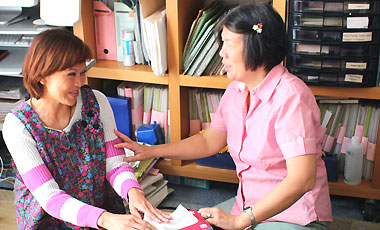By Steve Lalli

Over a 10-day period in May and June, two Maryknoll Sisters experimented with a plan to offer workshops in “liturgical dance” and “healing relationships” that helped people get in touch with the divine within themselves.
“Because the participants are our lay leaders to whom we give monthly study sessions, they were surprised that they learned many things through the body exercises and not necessarily from textbooks or lectures,” said Sister Margaret Lacson (at right in above photo).
Some workshops were held for Filipinas and parish leaders from across the Yokohama diocese. Another class was held at a parish near the Fukushima nuclear plant. As lay leaders, they are in touch with many in their own churches and can give help and guidance. All participants were Catholics and had the desire to learn about expressing prayer not only through words but through their own bodies. “One single mother (at a workshop) reflected that one exercise would help her to deal with her bi-cultural teenage daughter who’s in a rebellious stage now,” Sister Margaret said.
In Kamakura, Japan, where Sister Margaret is based, people struggling with such change are not hard to find, and that includes women who have come to Japan to find husbands and start families. They’ve come from places like the Philippines and other Asian countries. The benefits of these pre-arranged relationships are often mixed. The migrant women and their bi-cultural children often find it hard to adapt to Japanese ways. Domestic violence is another problem that is all too real, leaving behind physical and psychological scars.
“The workshops are helping us to be grounded in our own bodies,” said Sister Margaret. Though “we experience the world through our bodies,” she says, not everyone is successful at achieving such a mind-body balance. Part of Sister Margaret’s mission is helping Filipina women adjust to life in their new culture. “One single mother (at the workshop) reflected that one exercise would help her to deal with her bi-cultural teenage daughter who’s in a rebellious stage now,” said Sister Margaret, a Philippines-born missioner who is serving in cross-cultural mission in Japan as a Maryknoll Sister.
Sister Margaret (at right in photo, top) had to do was look around her to find people who could benefit from the techniques, which combine the use of dance to achieve a solemn, prayerful state. She gives a monthly training to lay leaders at a parish near the Fukushima nuclear plant to help parishioners help their neighbors who are suffering from radiation exposure as a result of the 2011 earthquake and tsunami.
During the workshops, Sister Margaret takes a supportive role as fellow Maryknoller, Sister Jeong Mi Lee (2nd from left in middle photo, foreground), introduces her sacred style of liturgical dance to Japanese audiences for the first time. During one of the sessions, Sister Jeong Mi showed how to breathe deeply and let the energy flow easily through her body. One of the women taking the class focused her breathing on her knee, where she was experiencing some pain. Somehow, the breathing exercise helped to ease the pain, and soon it appeared to be gone.
